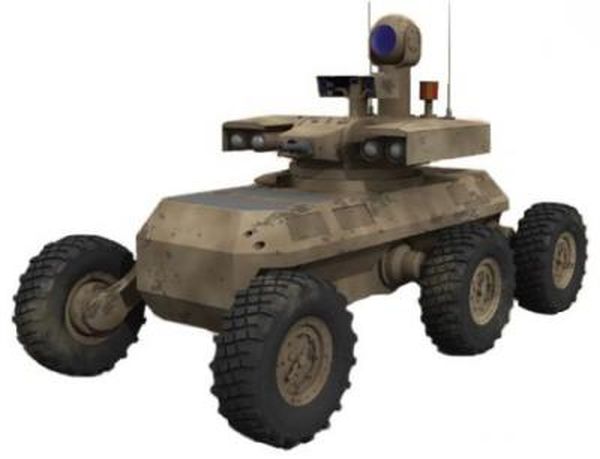Military Eatr Robot - But while robot dogs seem to be gaining ground throughout the U.S. military, the Army and Air Force have agreed to stay away from the canine pile. The military had two Boston Dynamics robotic dogs in its arsenal until it loaned one to Ukraine for mine-hunting purposes, but as recently as last October, military officials were not entirely committed to the idea of expanding the four-legged platform despite efforts to do so.
The (less noisy) robotic pack of mules began in 2004. Journalists asked questions, blog posts were written, and EATR became a human-eating robot in the public eye. Or, if not all, chopped with the chainsaw arm forward.
Military Eatr Robot
 Source: i.pinimg.com
Source: i.pinimg.com
Cyclone, Robotic Technology Inc, and DARPA quickly moved into disaster control, though they never guaranteed that the EATR would be powered by humans. "When the algorithms that control the robot dog allow it to move in a way that quickly adapts to any situation without getting in the way, then it will make sense," he continued.
Fuel Sources
“It's a really fun toy now though. "Ultimately, the robot itself is just delivering to sensors that collect information about the world and results that lead to changes in the world, even if something prevents something from blowing," Singer said.
By Jared Keller | Posted Mar 1, 2023 2:35 PM EST In mid-July, for example, the 5th Civil Engineer Squadron Chemical, Biological, Radiological and Nuclear (CBRN) team at Minot Air Force Base, North Dakota, unveiled robotic dogs that will replace both soldiers and service dogs in "
certain situations," according to the service. According to Minot's Northern Sentry, these Q-UGVs will allow aircrew to "deal with CBRN threats without risking their safety or that of others." "With this dog, we can strap on equipment and send it into space," 5th CES Senior Airman Karen Augustus told the Minot Daily News of the new Q-UGV.
"It's wearing a camera so we can see what's going on first. It'll help us eliminate the risk to airmen's lives." Securing and improving the ISTAR capabilities of US troops deployed to the world's hotspots appears to be the primary role for the dogs, but in the years since they have been adopted by Tyndall and other Air Force installations, Q-UGV operations have become available.
 Source: www.militarytrader.com
Source: www.militarytrader.com
Power Plant
more interesting than just guarding sensitive installations. Nearly three years have passed since robotic dogs first worked with service personnel in the United States Army, and the four-legged sensor platforms have found many new applications, becoming another pair of "eyes and ears" for soldiers around the world.
army. Maybe not exactly like this. Robotics Technology, Inc. hide footnote This “improvement” goes far beyond oversight. The same year that Tyndall began experimenting with robotic security dogs, pilots from the 621st Contingency Response Group at Nellis Air Force Base, Nevada, operated Ghost Robotics Q-UGVs during combat operations in which pilots raced to provide austere airfield defenses.
simulated enemy attack. Today, people are worried about how the robot army is becoming. For example, a recent video showing the ATLAS robot running in a forest raised concerns online. However, because he is fully connected to his power, this version of ATLAS is not much more than what we have seen many times before.
"These dogs will be another pair of eyes and ears in calculating the amount of information at strategic locations throughout Tyndall Air Force Base," said 325th SFS Commander Maj. Jordan Criss said in 2020 when Ghost Robotics began testing the Q-UGV in this installation.
"They will be a huge improvement for our defenders and allow for changes in the reporting and response of our staff." "What you're seeing is an increase in sensors and results because these dogs are doing more and more work," Singer said.
"Legs are notorious for what they carry, whether it's a soldier's backpack, chemical weapons, or a .50 caliber rifle." As previously reported by our colleagues at War Zone, Story Robotics is particularly interested in its Q-UGVs, which can carry a variety of unique payloads suitable for different skills.
 Source: designbuzz.com
Source: designbuzz.com
, tracking, target acquisition and reconnaissance (ISTAR) missions. But even as the Defense Department approaches the future of semi-guided weapons with AI guidance in mind, it's only a matter of time before America's robot dogs move from "sit and live" to "search and destroy."
EATR is programmed to eat certain plants and only those vegetables. EATR can consume biomass to convert it into fuel. The EATR can also use other fuels such as petrol, diesel, cooking oil or solar energy.
The company also includes "chicken meat" [4] as one of the proposed fuels in the project process. And it's not just American companies that are tracking these sources. As recently as last October (and just weeks after the robot dog maker's open letter on robot morality was retracted), a video from Chinese advocate Kestrel Defense saw an unmanned aerial vehicle shoot down a robot dog with a Chinese 5.8x42mm QBB-97 light machine gun strapped to it
back to the roof in a scene that feels straight out of an episode of Black Mirror. While their role in the U.S. military appears to be expanding, it's unclear whether semi-autonomous robotic dogs will ever move beyond a surveillance role to, say, combat—that is, his life as other docs in the room.
killer chain. . The major companies behind the Q-UGV technology (led by Boston Dynamics) wrote an open letter this October condemning the use of such a weapon by the government world. The project attracted some attention from the Internet and news after news that the robot would (or at least could) eat human remains.[2]
Cyclone Power Technologies has stated that animal or human biomass is not intended to be used in the robot's waste heat combustion engine[3] and the sensors will be able to distinguish between feed materials. [1] although the RTI project process states otherwise.
 Source: preview.redd.it
Source: preview.redd.it
sources include chicken fat.[4] But these warnings may not be as good as the world's military finding new ways to kill people. In October 2021, Ghost Robotics and SWORD International presented a special mission unmanned robotic dog equipped with a 6.5mm Creedmoor rifle on the floor of the Association of America Annual Conference in Washington, DC in a first example of the use of the weapon.
connected to Q-UGV. (This system, Parikh pointed out, is not autonomous and has no AI and requires a human operator to run it.) “If it [the robot dog] can move around on its own and orient itself where it doesn't need to take a leash.
, where it can move on its own and carry extra weight or ammunition or whatever, that's more important “But it all really depends on a lot of testing of these machines in the tactical room on the ground.
Soldiers must trust that the machine will move in the desired direction without getting in the way. Now it is very difficult to see what robot dogs can achieve. "The robot will be called the Energy Autonomous Tactical Robot, EATR for short. The Army hopes that EATR will be able to walk on its own for a year at a time and act as a service ambulance or a hazard. A project like this raises questions, of course, like what would happen if it chewed through
body of someone you know. We'll leave that question up to you in the comments for about now. The same goes for a missile disposal operation. As of 2020, Ghost Robotics has been working with EOD technology manufacturer Zero Point to develop the latest TITAN jamming solution for the capability on old Q-UGVs
keep explosive devices low, without personnel from dangerous situations In 2009, Cyclone Power Technologies partnered with DARPA and Robotics Technologies Inc. to create robots that don't need batteries or gas tanks at all.The goal is to create a robot soldier that can walk
 Source: img.haikudeck.com
Source: img.haikudeck.com
on a mission for a long time and feed around food without having to refuel or return batteries by humans. the rumble of the EATR battlefield of the future, roaming autonomously with drones overhead. During this operation, the robotic dogs were fed information targeting US military installations on the other side of the country through the Air Force's brand new Advanced Battle Management System (ABMS), so far as the Q-UGVs being “part of the attack.
and provide real-time attack intelligence to USAF personnel,” Ghost Robotics co-founder and CEO Jiren Parikh told our War Zone colleagues at a December 2020 meeting. Finally, in late August, the Naval Surface Warfare Center, Philadelphia Division unveiled a robotic dog developed by Boston
Dynamics and equipped with light and contains (LiDAR) sensors — essentially laser scanners based on the Q-UGV — with a special mission: "to create 3-D models of ships in "preserved "ships on commission at the Philadelphia Navy Yard," according to the Navy.
Then, in mid-August, the Coast Guard unveiled a group of "droid" robotic dogs to "counter the distribution of weapons of mass destruction" at the Honolulu, Hawaii program, demonstrating the Q-UGV's "location" capabilities. , removal and decontamination" can be terrifying "structures" and service workers in the United States, according to an image released by the service, although there are few details about the nature of the work. "Using Q-UGVs as damage assessment and inspection robots will save valuable man-hours that can
assign to other tasks that require high-level human thinking and judgment," said Senior Master Sgt. Kimberly Rumph, Cape Canaveral's director of innovation and technology at the time. "Most of our customers are using [Q-UGV] or developing applications for [CBRN]
, search, target acquisition, location and ground tracking, mapping, EOD operations, security, wireless mesh networks, perimeter security and other uses that need better capabilities than trackers and tires, which are less powerful and capable," Parikh told IEEE Spectrum
Source: farm3.static.flickr.com
in an interview for October 2021. Ghost Robotics Q-UGVs are specially designed to carry a suite of electro-optical, acoustic and other sensors to handle any obstacle femininity and in the toughest round, according to the Air Force.
From a document labeled "Apparently Many Scientists Have Never Seen a Single Horror Sci-Fi Movie": The Department of Defense has funded research into combat robots that power themselves by eating human corpses. What can go wrong?
It seems that scientists have a taste for enabling the death of the human species, so the project is called the Energy Autonomous Tactical Robot, or EATR. Wired.com readers who want to save time and trouble are encouraged to immediately start marinating in a mixture of 10W30 and Heinz 57 sauce. The robot is powered by a Cyclone engine, which is an external combustion engine, and a Rankine engine based on the Schoell cycle.
The motor will power the vehicle and is used to charge the batteries that power the sensors, arms and other accessories.[4] The purpose of the robotic dog has expanded. In late July, after Q-UGV's debut in Minot, the space force introduced its own fleet of friendly Ghost Robotics quadrupeds to provide coastal security, drop negative feedback and bolster the hurricane status warning team for Space Launch Delta 45 units responsible for space.
launched at Kennedy Space Center and Cape Canaveral Space Force Station in Florida. It is not entirely true what led to the rapid development of canine robots throughout the US military in just a few months last year, although Singer suggests that their widespread adoption will be the result of the spread of automatic systems in general (and Q. -UGV in particular) among the world's armed forces.